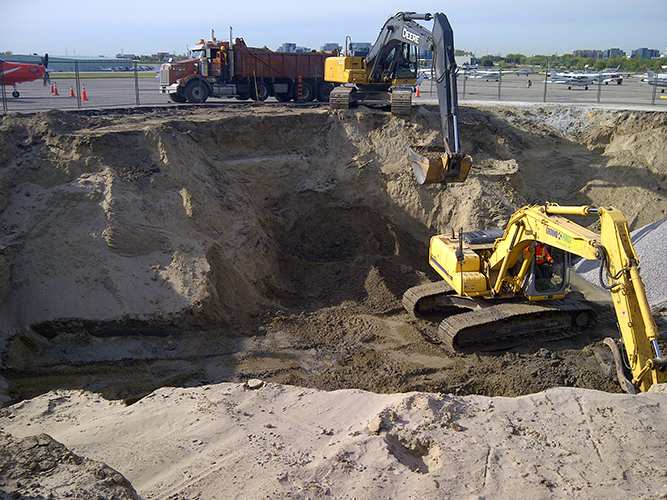Written by: Rob Mackenzie, Practice Lead in the Environmental Due Diligence & Remediation Group at Pinchin Ltd.
In April 2018, the Ontario Ministry of the Environment and Climate Change (MOECC) released a second, and significantly revised, version of the proposed Excess Soil Management Regulation for public consultation. The MOECC has stated that the key goals of the regulation are to protect human health and the environment from inappropriate relocation of excess soil, and to provide opportunities for the beneficial reuse of excess soil and reduce greenhouse gas emissions related to the movement of excess soil. In the past, the MOECC has provided best management practices for the handling of excess soil but these were not universally followed and the MOECC has decided to make the management of excess soil a legal requirement, with the onus on the generator of the excess soil to properly characterize the soil and ensure that the soil quality is suitable for the site receiving the excess soil.
If passed, the Regulation will be phased in two parts during 2020 and 2021.

January 1st, 2020
The first part of the regulation, will be effective on January 1, 2020, and will require that developers and other generators of excess soil retain a Qualified Person, as defined by Ontario Regulation 153/04, to characterize the quality of the excess soil at the source site by following MOECC requirements for soil sampling and analysis. The purpose of the soil characterization will be to ensure that the excess soil is of suitable environmental quality to be relocated to another property for reuse.
The MOECC has provided two sets of generic standards for use in determining whether excess soil is suitable for relocation. One set of standards are known as the “small volume” standards and can be used for volumes of excess soil up to 350 cubic meters (m3), or up to 1,000 m3 if a suitable rationale can be provided by a Qualified Person, and these standards are the equivalent of the current Site Conditions Standards in use under Ontario Regulation 153/04.
The second set of standards are known as “volume independent” standards and can be used regardless of the volume of excess soil. These standards are generally more stringent than the small volume standards as they account for increased contaminant loading not accounted for in the development of the small volume standards.
As an alternative to using the generic standards, site-specific standards for the site receiving the excess soil can be developed through the completion of a risk assessment or using the MOECC’s Beneficial Reuse Assessment Tool (BRAT). A Qualified Person can use the BRAT to modify the generic standards by inputting site-specific information (e.g., the absence of buildings at the receiving site) into the BRAT model.
January 1st, 2021
The second part of the regulation, will be effective on January 1, 2021, and will require the preparation of a soil management plan by a Qualified Person for the relocation of excess soil unless certain conditions apply (see below). The soil management plan will be filed on-line through an MOECC website, similar to the current process for filing Records of Site Condition.
Key components of a soil management plan include the following;
- An assessment of the past uses of the source site.
- A sampling and analysis plan for the characterization of the excess soil at the source site.
- A soil characterization report.
- A tracking system so that each load of excess soil can be tracked.
- The destination of the excess soil.
- A contingency plan in the event that additional contaminants not identified through the initial characterization are discovered during excavation.
A soil management plan will not be required under the following scenarios;
- If the excess soil originates from a property that has never been used for industrial purposes or as a garage, a bulk liquid dispensing facility including a gasoline outlet or a dry cleaning facility, the primary purpose of the soil excavation is not the remediation of contaminated land, and the property is located in a non-urban area.
- If the amount of excess soil is less than 100 m3 and the soil is transported directly to a waste disposal site.
- If the soil is being excavated under an emergency situation (e.g, to reduce the danger to human health and/or the environment), in response to an order from a regulator, or to maintain infrastructure except for the excavation of soil to maintain a stormwater management facility.
- If all the conditions in the first bullet are met and the excavated soil is top soil.
Please note that the above summary is based on the version of the Regulation currently posted to the Environmental Bill of Rights registry and the Regulation may be modified based on comments received by the MOECC through the public consultation process.